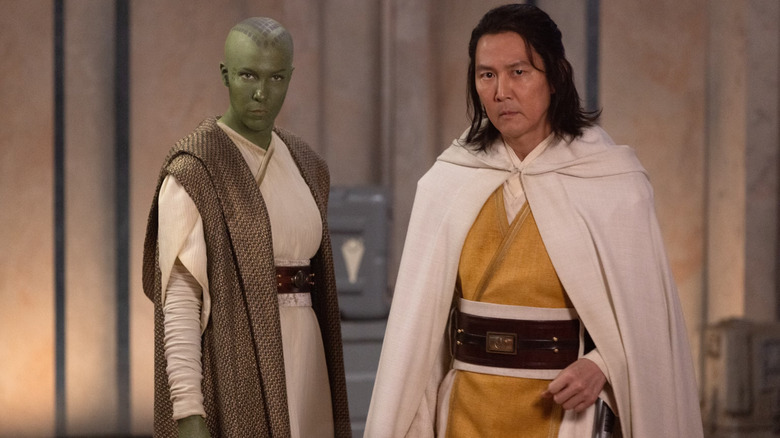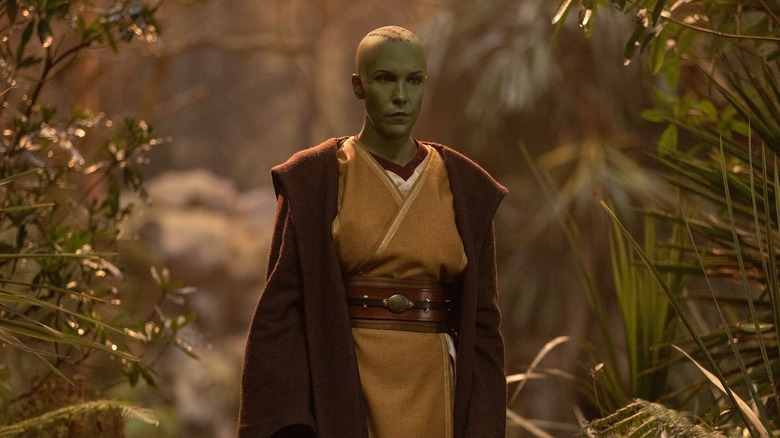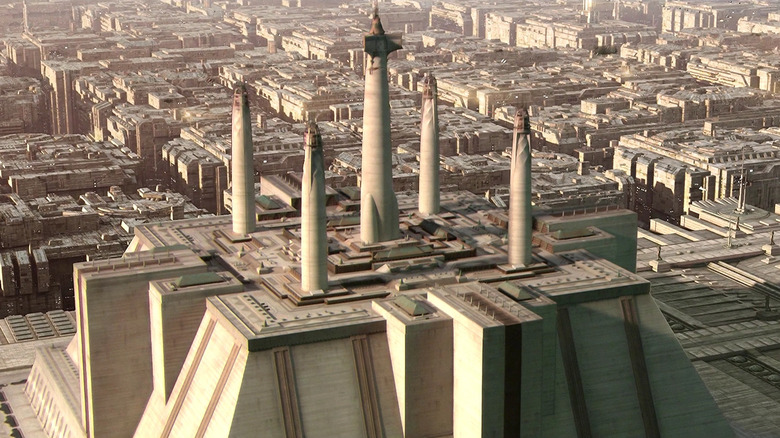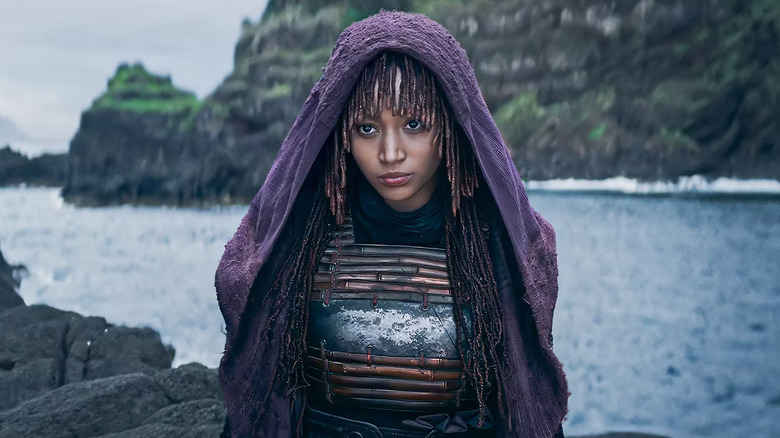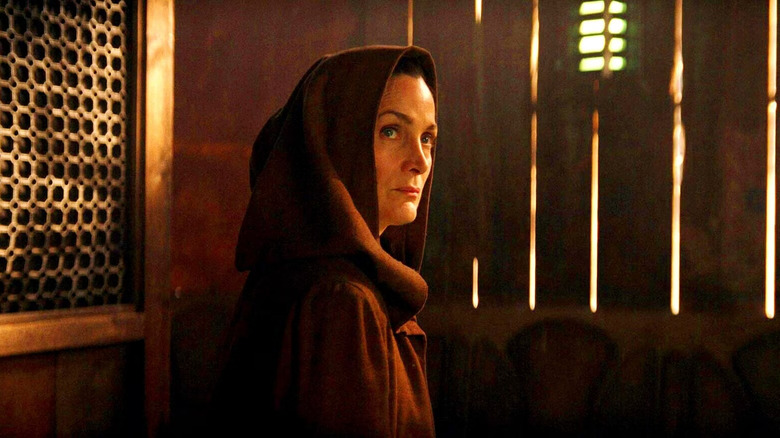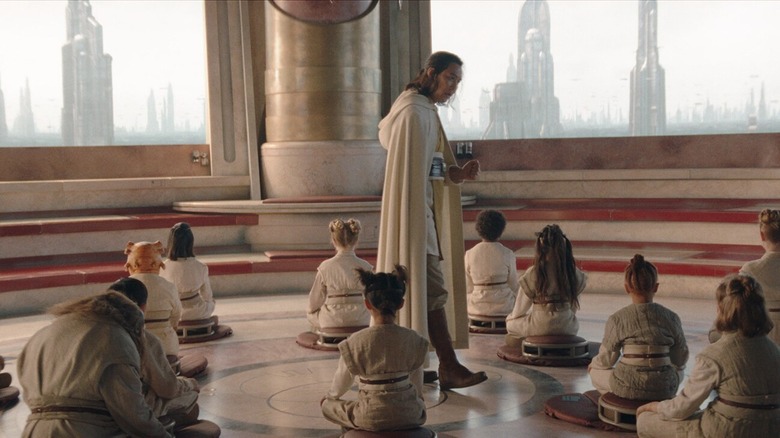The Acolyte Review: The Prequels Get Their Own Version Of The Force Awakens With This Star Wars Series
Sometimes, the "Star Wars" universe can seem very small. The vast majority of television we've seen on Disney+ that takes place in a galaxy far, far away is intrinsically tied to the Skywalker Saga in one way or another. Even "Andor" ties directly into the Rebellion and the work of Princess Leia and the people of Alderaan, and it might be the one that feels most removed. The universe of "The Mandalorian" felt separate for a while, but Luke Skywalker's appearance in season two brought it right back into the world of the classic trilogy.
For most "Star Wars" fans — myself included — this small universe phenomenon where everything is connected is a feature, not a bug. That doesn't mean it's not still refreshing to see things completely divorced from the Skywalker Saga and gives us a new window into "Star Wars," and that's exactly what Leslye Headland's murder mystery series, "The Acolyte" offers us. A look at something new in "Star Wars" that we haven't yet seen in live action: a story that is removed from the timeline, characters, and events of the Skywalker Saga. It's an exciting breath of fresh air I didn't know I needed, and offers us something at once familiar but also genuinely unexpected.
The Acolyte heads to the High Republic era
Part of what makes it easy for "The Acolyte" to separate itself from the Skywalker Saga is the fact that it's set a hundred years before the events of "The Phantom Menace." Though there are major characters who are old enough to crossover, most notably Yoda and Chewbacca, as well as secondary characters like some members of the Jedi Council (Yaddle, Yarael Poof, Oppo Rancisis, etc.), none of them are present, at least in the first two episodes that kick off the premiere of "The Acolyte." The show is also set at the end of The High Republic era, more than a hundred years after we've seen any storytelling in the era that kicked off in the pages of Charles Soule's "Light of the Jedi" in 2021. The High Republic shows us a time in the "Star Wars" universe where the frontier of the galaxy is still being explored and it's a little bit like the wild west. Jedi are a little bit more like the Knights of the Roundtable than the Jedi Knights we see in the Skywalker Saga and the technology is just a little bit older and clunkier. Communication was more difficult and hyperspace lanes weren't as mapped out, giving rise to prospectors seeking out the safest routes in the galaxy.
To this point, we've only been able to experience this era of the galaxy in the pages of books and comics, as well as the animated kids show "The Young Jedi Adventures." But as far as live-action, "Star Wars: The Acolyte" is the first and hopefully not the last foray into this part of the timeline. The show brings us to places new and old, ranging from the Jedi Temple on Coruscant to the edges of the known galaxy, making it feel distinctly familiar as "Star Wars," but new all at the same time.
The only returning character from The High Republic era — at this point — is Jedi Master Vernestra Rwoh, played by Rebecca Henderson. Introduced in both "Light of the Jedi" and the incredibly fun book "A Test of Courage," Vernestra has a storied history with the Jedi as the youngest Padawan ever to become a Jedi Knight. Naturally, this story takes place more than a century later, so she has experienced quite a lot since we last saw her. Henderson brings a depth of history to the character that shows us just how much she's been through without having to say it, and that gravitas of the past is something that feels very "Star Wars."
Prequel fans will rejoice over The Acolyte
If J.J. Abrams brought his love of the original "Star Wars" trilogy to the screen with 2015's "The Force Awakens," Leslye Headland brought that same love of the prequel trilogy to "The Acolyte." It feels like it exists in that same universe and feels like the Jedi are finally on the edge of the precipice that will lead them to a path of destruction thanks to the Sith's grand plan. Showrunner, writer, and director Leslye Headland told The Wrap in 2021 how important "The Phantom Menace" was to her at a formative age:
"I was 18 when 'Phantom Menace' came out and I was a very, very big 'Star Wars' fan. I remain a big 'Star Wars' fan, but at that particular time, right after the re-releases and the fact that I was in high school, it just kind of all coincided at a time where I was discovering who I was sexually, I was discovering who I was artistically, I was kind of realizing what I wanted to do with my life. And then this big, huge movie event, cultural event happened that was 'The Phantom Menace.'"
That influence is on clear display. From the inclusion of factions like the Trade Federation to the way the visuals play out and how she handles the Jedi, it feels like a very natural, hundred year-old extension of how we got there. Where Abrams had so many visual and thematic references to what "A New Hope" meant to him, Headland brings those same things together from "The Phantom Menace," and the rest of the prequel trilogy. So much of the forward propulsion of the show has the same mysterious trajectory that "Attack of the Clones" attempted to unravel, and the music (composed by Michael Abels) in many places seems to make various nods to that direction as well.
The Acolyte is a murder mystery
The story, as many have seen in the trailers, revolves around a shocking mystery: someone is murdering Jedi. Like most good detective stories, this one too starts with the drop of a body and a whole lot of unanswered questions. At first, the pulse-pounding detective yarn feels easily solved, but deeper and more complex than anyone — in the audience or in the show — realize. Nothing is what it seems and as the Jedi sent to solve the murder peel back the layers on who is killing Jedi and why, they're left with more questions and troubling realizations.
The audience has an easy time coming to the conclusion that the motives are more important to unlocking the secrets of the show than the identity of the murderer. As the investigators navigate through this troubling mystery, answering one question raises two more, keeping the audience guessing in ways I was surprised by. That's part of why this section of the timeline is so exciting, but still feels familiar enough to be comfortable. With one exception, all of these characters are new, imbued with a deep sense of their own personal history, but because we don't know where they're going and have another hundred years of uncharted territory, literally anything can happen.
For the first two episodes (of eight), it feels as though the surface has barely been scratched as we learn more about what is actually going on and who might be behind it. We know for certain there is a powerful dark side user at the center of the mystery, but where could this all be leading?
Each episode offers something new and tantalizing and just when we think we have a handle on what that deeper mystery would be, our question is answered and we realize we weren't asking deep enough questions to begin with. It's a really well-wrought detective story that is unlike anything I've seen in "Star Wars" before.
The Acolyte pays tribute to classic Kung Fu cinema
Layered on top of the energizing detective story structure of "The Acolyte" is the influence of classic kung fu action films. One of the big scenes shown features Jedi Knight Indara (Carrie-Anne Moss) facing off against a mysterious warrior, trained in the ways of the Jedi, but also the dark side. Except for the inclusion of lightsabers, the fight sequences look like they could fit right at home in Ang Lee's "Crouching Tiger, Hidden Dragon" or Zhang Yimou's "Hero."
The influence goes even further back, obviously, but there is definitely a style to this sort of sword-fighting that looks back into cinema, but also to its "Star Wars" roots. "The Phantom Menace" gave us Darth Maul and his acrobatic fighting style and this show looks like it's doing everything it can to match that aggressive fighting on screen, lightsabers and all. It's one more touchstone to how Leslye Headland is reaching back to the origins of the "Star Wars" of her teenage years. Where J.J. Abrams went back to whiz kid mechanics on desert planets blowing up a large, ball-shaped superweapon, Leslye Headland is bringing the kung fu saber duels back to the foreground.
The verdict (after two episodes)
What's impressive about Leslye Headland juggling these different bits of influence in the "Star Wars" universe is that she's succeeding. The first two episodes hum with life and new ideas, but also challenge our understanding of good and evil, right and wrong, and the age-old conflict between Jedi and Sith.
There was once a prophecy of one who would bring balance to the Force, and it seems like Headland is bringing a different kind of balance to her storytelling. Where humor and heart are balanced equally against grimy grit and revenge. Where exciting bright and exciting visuals are matched against those that are dark and devastating. The show walks that careful razor's edge between light and dark, and it starts off with a shocking bang.
"That's impossible," Anakin Skywalker told Qui-Gon Jinn in "The Phantom Menace," "No one can kill a Jedi."
And Qui-Gon offers a pained and mused laugh. "I wish that were so."
And as we watch "The Acolyte", we, too, wish Anakin were right. But he's not. Someone is killing the Jedi. But who? And why? Harder to answer. Where the story unfolds from the two-episode premiere is anyone's guess, but it's safe to say that I'm on board for this particular jump into hyperspace.
/Film Rating: 8 out of 10
"Star Wars: The Acolyte" begins today, June 4, with its two-episode premiere at 9pm Eastern, only on Disney+.
